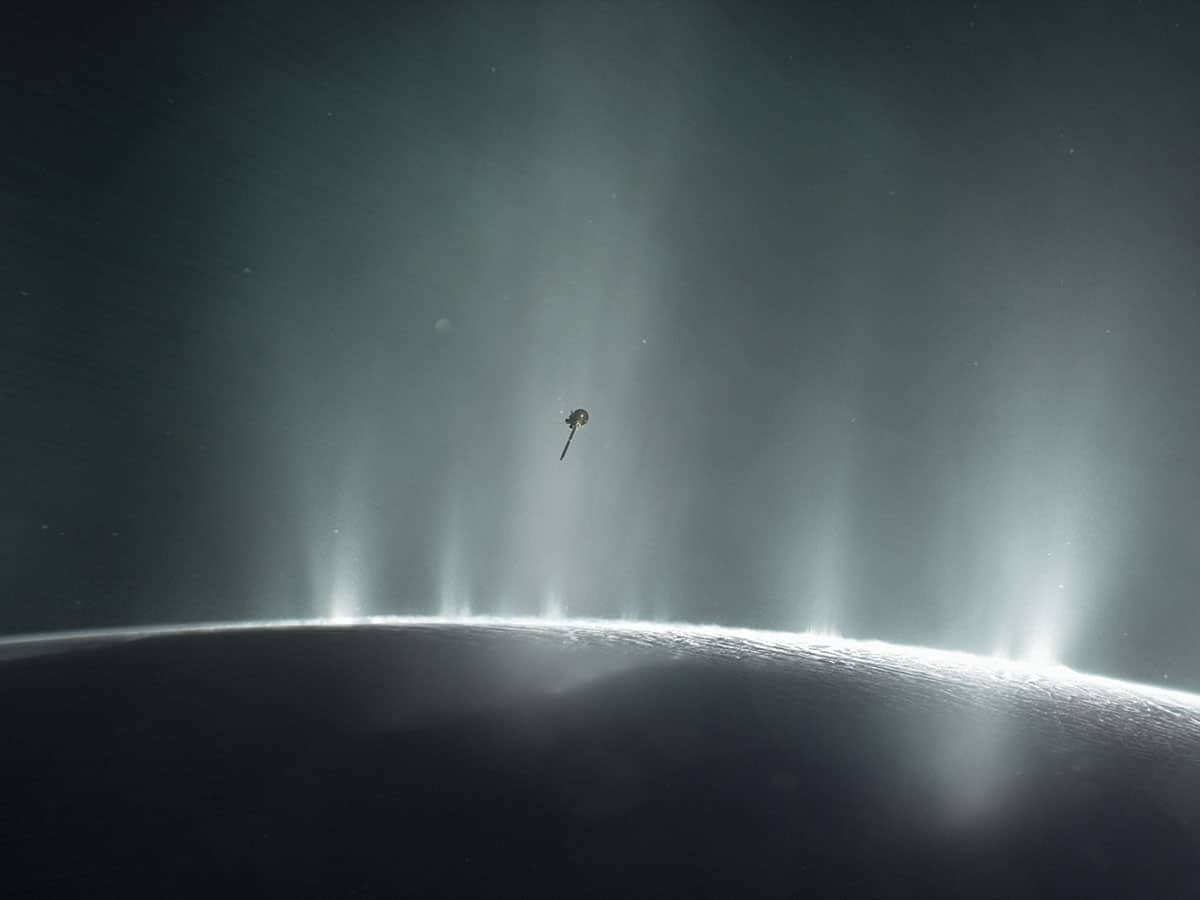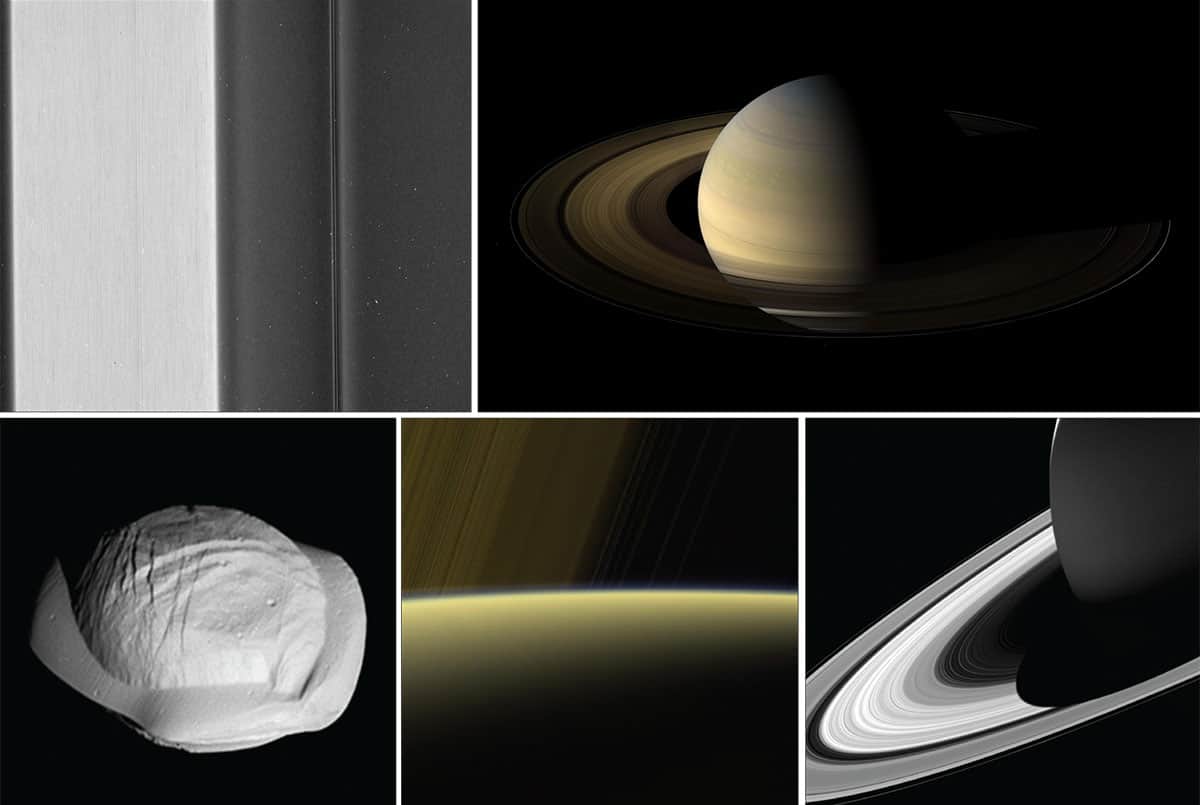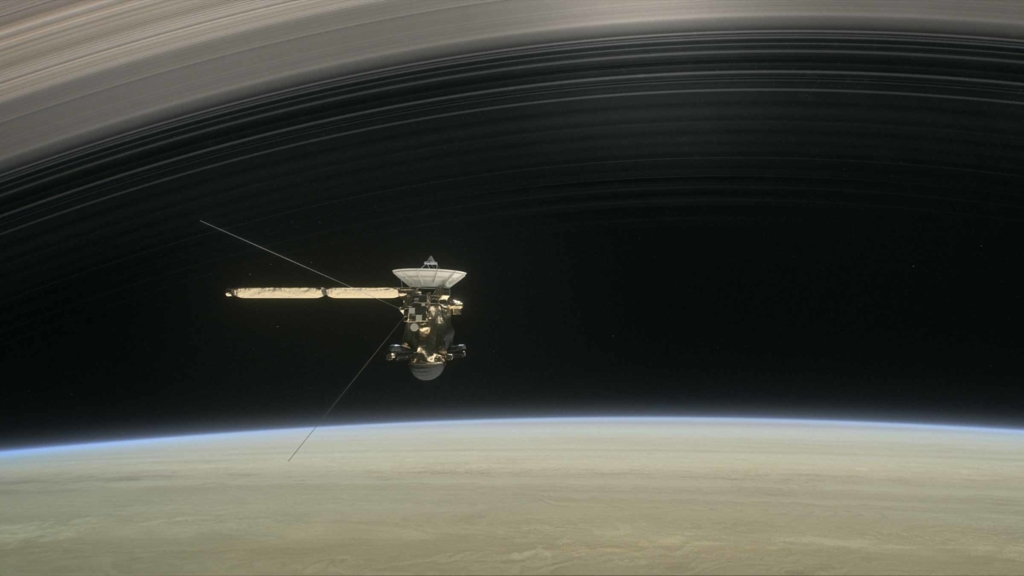Flying closer to Saturn than ever before, the Cassini spacecraft has spent the last few months diving between the planet and its rings, collecting new and unique data ahead of its suicidal plunge into the planet on 15 September, as Joshua Colwell reveals
After spending more than 13 years as an artificial moon of the most famous ringed planet, NASA’s Cassini spacecraft will plunge into Saturn’s atmosphere on 15 September. One month shy of 20 years in space, its mission will finally be complete. Unlike some planetary missions that have ended with gradually diminishing capabilities, however, Cassini will have been returning some of its most spectacular and unique data right up to its sudden and dramatic demise.
That is because, since April this year, the spacecraft has been flying closer to Saturn than ever before, for the first time passing in-between the rings and the planet in 22 unprecedented orbits. With 11 of Cassini’s 12 instruments still operating, its “Grand Finale” tour has not only been providing the highest-ever-resolution images of Saturn’s atmosphere, rings and moons, but its snug orbits have also been enabling an entirely new scientific investigation of the planet’s interior.
The story so far
The Cassini orbiter was launched on 15 October 1997, along with the European Space Agency’s Huygens lander, which it was to deposit on Saturn’s moon Titan. Arriving in 2004, Cassini’s initial mission at Saturn was planned to last for just four years, but the rapid pace of discoveries led to two extensions of the mission. First there was the two-year Equinox mission from 2008 to 2010 and then the Solstice mission, which takes Cassini to its final orbit.
Cassini’s tour of the Saturn system has revealed surprising and dynamic features at every turn. Its largest moon Titan has lakes confined to the polar regions. Enceladus, another moon, was discovered to have active geysers of water vapour and ice spewing from its south pole with unknown variability. The rings, meanwhile, revealed moonlets embedded within them, some apparently breaking apart before our eyes, producing clouds of dust that spiralled around the planet.
An additional feature of the rings is that they cast an enormous shadow on the atmosphere, which moves across the planet over the course of a Saturn year – equivalent to 29 Earth years. During the Equinox mission, however, the Sun was directly above Saturn’s equator, which is also the plane of the rings. This allowed Cassini to observe Saturn’s atmosphere with virtually no ring shadow, and to observe the slight shadow cast by the rings. Rather than being entirely flat, the ring shadow revealed out-of-plane features, including a periodic ripple across the innermost D ring, which, in 2011, Cassini scientist Matt Hedman and colleagues attributed to the impact of cometary debris with the ring in 1983. The rings really are changing before our eyes.
What lies beneath
A gas giant, Saturn’s thick and opaque atmosphere shrouds what lies beneath, keeping the structure and composition of its interior the planet’s biggest remaining mystery. This question is not only interesting in itself, but also because much of what sculpts the rest of the Saturn system is determined by events inside the planet.
The most widely accepted model of Saturn’s formation is that a solid core of ice and rock accreted from smaller planetesimals, in much the same way that the terrestrial planets such as Earth formed. In this “core accretion” model, the solid core provided the gravitational nucleus that allowed the planet to capture most of its mass from the gas in the protoplanetary nebula. But whether that core is one tenth or one quarter the mass of the planet is unknown. The structure of the outer parts of Saturn’s interior, a mixture of hydrogen and helium, is also poorly understood.
What we do know so far about Saturn’s interior has been pieced together from lots of different lines of evidence, with theoretical and laboratory-based models complementing Cassini’s observations. These include bright auroras and coloured moons, both of which are caused by belts of charged particles shaped by a magnetic field generated somewhere in Saturn’s interior. Cassini has also detected waves in the rings that are produced by resonances with moving mass anomalies in the planet’s interior, pointing to an interior that is both lumpy and dynamic.

Even something as apparently straightforward as knowing the rotation rate of the planet’s interior proves complicated for Saturn. Radio waves emitted by Jupiter, in contrast, are thought to tightly correlate with the rotation of the bulk interior of the planet. The comparable radiation from Saturn, though, has multiple components and has changed over the years. So just what is going on inside this planet?
New and unique data
From May through to September this year, Cassini has been flying closer to Saturn than ever before. Passing just 1628 km above Saturn’s cloud-tops, Cassini’s proximity has enabled a series of first-time measurements that will tell us more about the interior of the planet.
First, we are getting a more highly resolved view of Saturn’s magnetic field. Seen from a great distance, its magnetic field looks like that of a simple bar magnet, but as Cassini gets close to the source of that magnetic field, we have found it deviates from a perfect dipole. Those deviations, measured during the Grand Finale orbits, are giving us a more highly resolved view of Saturn’s magnetic field, providing us with clues to the processes inside the planet that are producing it. Saturn’s magnetic field can be measured both directly using magnetometers on Cassini, and indirectly by using Cassini to measure the radio waves produced by charged particles that are guided by Saturn’s magnetic field.
Cassini is also measuring the distribution of material in Saturn’s interior. From a long way off, the mass of Saturn and even its moons and rings can be lumped together and approximated by a single point. But because it has a density less than water and rotates so fast (one day is about 10.5 hours), Saturn is highly flattened and the distribution of material in its interior is uneven. And the closer one gets to Saturn, the more these differences from a spherically symmetric planet come into play.
To measure the gravitational field of Saturn, we take advantage of the fact that Cassini is actually falling around the planet, and during six of the 22 close orbits, known as the “gravity passes”, it makes no manoeuvres at all. The spacecraft’s speed is therefore entirely determined by the gravitational pulls of Saturn, its moons and its rings, and at close distances, the lumpiness of Saturn’s interior produces measurable changes in its velocity.
Cassini transmits data to us via a radio signal, which is tracked by large radio telescopes on Earth that are part of the Deep Space Network. By precisely measuring the Doppler shift in the radio signal as Cassini’s speed relative to the Earth changes, the speed of the spacecraft can be determined to a precision of just 17 µm/s, which is an impressive feat considering that Cassini’s top speed relative to Saturn is more than 34 km/s. These data can then be used to reconstruct the distribution of mass in the planet, and, crucially, to determine the mass of the rings distinct from the mass of the planet.
To get all of this correct requires extraordinary care. As team leader of Cassini’s Radio Science Subsystem Richard French explains, “In an early solution for the gravity field of Saturn, an error in the position of a Deep Space Network station of only 10 cm due to plate tectonics on the Earth resulted in a physically implausible solution for the gravity field.”
Riddles of the rings
Saturn’s interior may still be hidden from view, but astronomers have been gazing at its rings – one of the most striking features in our solar system – since the 1600s, and it has long been an embarrassment to me that I’m unable to answer two basic questions about them: how old are they and where did they come from?

Before the Voyager fly-bys of Saturn in the early 1980s, it was thought that the rings were as old as the planet itself, being the leftover debris from the formation of the planet, much as asteroids and comets are leftovers circling the Sun. The idea was that ring particles are too close to Saturn to coalesce into moons the way the more distant leftover material did. Instead they are consigned to circle the planet in a crowd, jostling ever-so-gently with each other every few hours, never accumulating to form more than a large, temporary snowdrift of material. But when the Voyagers showed that there is structure in the rings that would be hard to maintain for the 4.5-billion-year age of the solar system, this old-rings theory no longer made sense and, instead, the once-radical idea of a recent origin for the rings was explored.
Cassini’s detailed exploration of the system has provided even more evidence for a young ring system. From measurements of the reflectance of the rings at different wavelengths we have known for decades that the rings are primarily water ice. Indeed, their surfaces indicate a composition of roughly 99% water ice. The puzzle is that the rings are like a giant bulls-eye in space for all the tiny bits of debris moving through the solar system – micrometeoroids shed from comets and collisions among comets and asteroids – to hit. Those particles, smaller than a millimetre, should darken the ring particles when they hit them, not unlike when freshly fallen snow on the Earth turns black from dirt and pollution.
To determine the age of Saturn’s rings we can therefore figure out how long it would take them to reach their current state of 1% non-ice “pollution” from interplanetary debris, assuming they started as pure water ice. To work this out, two things must be known: the rate of dirt hitting the rings, and the degree to which this dirt gets buried in the interior of the ring particles.
Cassini’s Cosmic Dust Analyzer has already allowed us to figure out the incidence of dirt landing on the rings. After painstakingly analysing more than 10 years of data in which the impacts from interplanetary dust particles were sifted out of the much more numerous impacts by icy grains in Saturn’s E ring, scientists working on this instrument determined that the rate of in-falling material would darken the surfaces of Saturn’s ring particles from an initial pure ice state to their current brightness in just about 100 million years.
As for the degree to which the dirt gets buried in the rings, finding out the mass of the rings would help to answer this, as massive rings provide a greater reservoir in which to bury the dirt. Massive rings are also harder to explain with models of a recent origin that require either the break-up of a moon or the tidal capture and disruption of a passing cometary body. Less-massive rings, on the other hand, make it harder to explain the brightness of the rings if they are as old as the solar system, and are a bit easier to explain with recent origin models. Current estimates of the ring mass vary by about a factor of 10. The Grand Finale orbits may put the nail in the coffin for ancient rings, or they may reopen the question.
Final goodbye
I will be in Pasadena early in the morning on 15 September, gathered together with many of the Cassini extended family, to witness the final disappearance of the radio signal from Cassini. After plunging into the atmosphere, and shortly before burning up as a meteor, friction will make it impossible for the spacecraft to maintain a radio connection with the Earth. The disappearance of that final radio signal will be witnessed live by thousands of people who have worked on the project, some, like me, for more than 25 years.
I cannot know what emotions I will feel because it is an unprecedented event for me, but it will be a kind of death. I have worked on Cassini for my entire professional life. After the mission, the family will disperse and the clans will not assemble again. However, as we say goodbye to our robotic friend who has tirelessly explored the vast Saturn system, faithfully executing tens of thousands of observations, we will look forward to answering the many scientific questions that Cassini will leave behind as its legacy, long after it has become part of Saturn.
Quirks and clans of the Cassini family

I started working on Cassini in 1990 as a fresh postdoc for my dissertation adviser, Larry Esposito, who had just been selected to provide the Ultraviolet Imaging Spectrograph for the mission. Over the course of the next 27 years I’ve been part of a large extended family of Cassini scientists and engineers. We wrestled with a changing spacecraft design and then years of work to refine the trajectory or “tour” of the Saturn system that the spacecraft would follow.
This extended family had lots of clans: the rings clan, the Titan clan, the imaging team clan and so on. Each clan had regular meetings. For years I had a weekly telecon meeting of the Rings Target Working Team (invariably referred to as the “rings twit”) where we would debate various observation proposals to arrive at an optimized timeline of observations down to the minute. We had a close and friendly working relationship on the phone, and then every six months or so there would be face-to-face meetings of cross-sections of these clans. I would often know people by their voice and had extensive discussions with them, despite never having met them face-to-face.
The project seemed to be enamoured of complex Excel spreadsheets to score various proposals (for example, which tour to fly) with a green–yellow–red colour-coding scheme. One clan (say Titan), might score a tour with lots of green, while Rings would show a red-and-yellow spreadsheet for that same tour. Sometimes we would close our eyes and find those endless boxes of red, green and yellow burned onto our retinas. There was a certain culture that grew organically over the course of the mission. We all knew our Cassini lingo of twits, revs (revolutions, or orbits, of Cassini around Saturn), RBOT (a computer program that checked that a planned “sequence” of activities wouldn’t leave the reaction wheels spinning in a dangerous state), PDT (the Pointing Design Tool used to create files to generate commands to transmit to Cassini to tell it where to look) and many more.
As the mission wore on, we grew older, new people joined the project, some moved on and, sadly, some died. Some milestones have already passed. There will never be another rings twit telecon, nor will there ever be another satellite fly-by, radar observation of Titan or project meeting at ESA’s ESTEC (European Space Research Technology Centre). After 15 September, we will never get another notice of new data downloaded from Cassini – something that has occurred with remarkable reliability for more than a dozen years. I’ll cross paths with my Cassini colleagues not at team meetings or project science meetings, but at larger international science conferences, if at all. Shared science questions will continue to bind some of us together, but with the spacecraft gone, some connections will fade away. And I will miss them.




